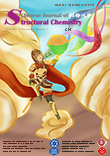
Cover Picture
Progress and
Understanding on Catalysts with Well-Defined Interface for Boosting CO2 Conversion
Binran Zhao, Yiyi Zhao, Peng Liu, Yulong Men, Xinyu Meng and Yunxiang Pan*
In the cover picture, we adapt
the ideal from "Journey to the West," one of Chinese four literary
classics. The ancient Chinese mythical character, Monkey King, holds a treasure
in his hand, which represents the catalysts with well-defined interface. CO2 is blown out from the mouth of Monkey King, then goes through the catalyst
interface, and finally is converted into high value-added chemicals like CH4,
CH3OH and CO. This well describes the focus of our paper titled “Progress
and Understanding on Catalysts with Well-defined Interface for Boosting CO2 Conversion”.
Submit a Manuscript
Atomically
Thin 2D TiO2 Nanosheets with Ligand Modified Surface
for Ultra-Sensitive Humidity Sensor
Jianze Xiao, Zhihua Fu, Guane Wang, Xiaoliang Ye* and Gang Xu*
Chin. J. Struct. Chem. 2022, 41, 2204054-2204060 DOI: 10.14102/j.cnki.0254-5861.2022-0046
April 8, 2022
TiO2 nanosheet, ligand modification, ultra-sensitive, chemiresistive, humidity sensing
ABSTRACT
As a kind of
two-dimensional (2D) nanostructured materials, metal oxide nanosheets (MONS)
are attractive and promising humidity sensing materials due to their
considerable surface area, good charge carrier transportation, and designable
surface functional groups properties. Nevertheless, the ultra-thin MONS
modified with active functional groups for humidity sensing are still rare. As
a proof of concept, the atomically thin TiO2 nanosheets with high
surface area and electron-donating amino groups are prepared by a
structure-maintained post-ligand modification strategy. The fabricated TiO2-based
sensors demonstrate superior humidity sensing performance with high response,
short response time, narrow hysteresis, and ultra-low theoretical limit of
detection of about 15 ppm. Additionally, the possible mechanism is proposed
from the AC complex impedance measurements and DC instantaneous reverse
polarity experiments. This work provides a possible path for developing the
high-performance 2D nanostructured metal oxides-based humidity materials through the surface chemical
method.







